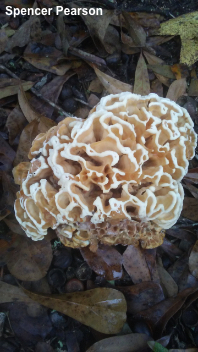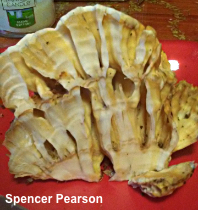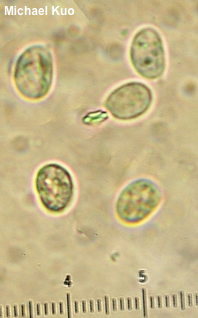| Major Groups > Clubs & Corals / Polypores > Sparassis > Sparassis spathulata f. herbstii |

|
Sparassis spathulata f. herbstii [ Basidiomycota > Polyporales > Sparassidaceae > Sparassis . . . ] by Michael Kuo By current definitions Sparassis herbstii is a "morphological variant" of Sparassis spathulata, rather than a distinct species (see Petersen et al. 2015). It shares the primary defining features of Sparassis spathulata: flattened rather than "noodly" branches, association with pines or oaks, and (under the microscope) a lack of clamp connections. However, Sparassis spathulata f. herbstii has thicker, whitish branch tips, measuring 2–4 mm thick, while the typical form has very thin branch tips that are under 1 mm thick. Other features putatively separating f. herbstii include the tendency of the branches to be more evenly colored, rather than zoned, and the lack of pinkish hues as the branches mature. However these features, which come from Peck's original description of Sparassis herbstii (1895), have been de-emphasized by Petersen et al. (2015) in favor of the thickness of the branch tips, which Peck called "dilated above." Whether or not Petersen's morphology-based hypothesis will be supported by DNA evidence remains to be seen. Thanks to Spencer Pearson for documenting, collecting, and preserving Sparassis spathulata f. herbstii for study; his collection is deposited in The Herbarium of Michael Kuo. Description: Ecology: Pathogenic and saprobic; growing from the roots or bases of trees; found under hardwoods (especially oaks) or pines (species of Pinus, with bundled needles); annual; causing a brown rot or a butt rot; summer and fall; originally described from Pennsylvania; precise distribution uncertain, but probably fairly widely distributed in North America east of the Great Plains and below the Great Lakes. The illustrated and described collection is from Mississippi. Fruiting Body: 8–16 cm across; up to 12 cm high; forming a rosette of flattened branches which arise from a common, fleshy basal structure; branches thin-fleshed, with thickened, contrasting white upper edges (2–4 mm thick), creamy whitish to yellowish or brownish overall, featuring concentric zones of color, bald; flesh whitish, unchanging when sliced. Odor and Taste: Not distinctive. Microscopic Features: Spores 5–7 x 3.5–5 µm; ellipsoid; apiculate; smooth; hyaline in KOH; inamyloid. Basidia to 42 x 6 µm; subclavate; 4-sterigmate. Cystidia not found. Contextual hyphae 3–8 µm wide; smooth; walls to 0.5 µm thick; hyaline in KOH; clamp connections not found. REFERENCES: (Peck, 1895) R. H. Petersen, 2015. (Coker, 1921; Petersen et al., 2015.) Herb. Kuo 11061801. This site contains no information about the edibility or toxicity of mushrooms. |
© MushroomExpert.Com |
|
Cite this page as: Kuo, M. (2021, June). Sparassis spathulata f. herbstii. Retrieved from the MushroomExpert.Com Web site: http://www.mushroomexpert.com/sparassis_spathulata_herbstii.html |


